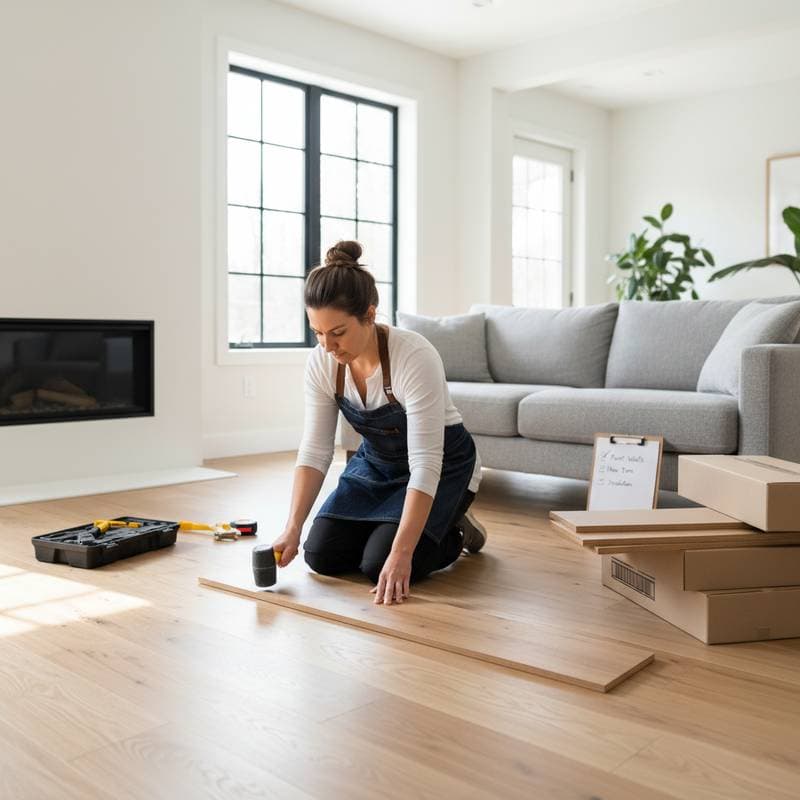3. Cabinet Refacing
Refacing kitchen or bathroom cabinets refreshes the look without full replacements or structural changes. This involves applying new veneer to existing frames and doors, typically exempt from permits. Costs range from $1,000 to $4,000 for a standard kitchen, covering kits and hardware.
Disassemble doors and drawers carefully, labeling hardware for reassembly. Sand surfaces lightly before applying adhesive-backed veneers. Install new hinges and pulls for a modern finish. This approach saves time compared to full teardowns.
When to Upgrade: Focus on high-traffic areas like kitchens. Pair refacing with new countertops if budgets allow, but confirm countertop swaps remain permit-free in your area.
4. Lighting and Fixture Replacements
Replacing an existing light fixture, ceiling fan, or faucet does not require a permit as long as the wiring or plumbing remains unchanged. Quality fixtures range from $50 to $400 each. Stick with UL-listed electrical components and use proper grounding.
Turn off power at the breaker before starting. Remove old fixtures by disconnecting wires and mounting brackets. Connect new ones following color-coded instructions: black to black, white to white, and ground to ground. Test functionality before final securing.
When to Call a Pro: If you find aluminum wiring or outdated plumbing connections, stop. Licensed electricians or plumbers are required for those updates. This precaution prevents hazards and ensures compliance.
5. Deck Resurfacing
Resurfacing an existing deck with new boards or composite materials qualifies as maintenance in many locales, avoiding permit needs if the structure stays intact. Expenses total $800 to $2,500 for a 100-square-foot deck, including decking and fasteners.
Inspect the frame for rot before proceeding; replace damaged joists only if non-load-bearing. Screw down new boards perpendicular to joists for stability. Apply a weather-resistant sealant after installation to extend lifespan.
Quick Enhancement: Add railings or lighting if they match existing specs. These additions improve safety without expanding the footprint.
6. Insulation and Weatherproofing
Improving energy efficiency does not always need a permit. Adding insulation to attics or sealing windows can save 10 to 20 percent on energy bills. A full DIY attic insulation job runs about $1,000, while professional installation can reach $3,500.
Choose fiberglass batts or blown-in cellulose based on space access. Wear protective gear during installation to avoid irritation. Seal gaps around windows with caulk and add foam tape to doors for airtight barriers.
Quick Win: Use expanding foam or weatherstripping around doors to reduce drafts before winter. These small steps yield immediate comfort gains.
Decision Framework for DIY Projects
Evaluate each project methodically to balance safety, feasibility, and benefits. Consider these three key questions before proceeding:
- Safety: Does this project expose wiring, gas, or load-bearing elements? If yes, hire a professional immediately.
- Complexity: Can you complete it with common tools and online tutorials? Limit efforts to simple surface tasks.
- Return on Investment: Will this enhance comfort or resale value? Target upgrades that deliver dual advantages.
Hesitation signals the need for expert advice. Local contractors frequently provide free consultations and clarify permit thresholds. Obtain three quotes from nearby professionals to gauge costs, timelines, and local requirements.
Protecting and Maximizing Your Upgrades
Well-executed permit-free projects build lasting value through enhanced interiors, reduced energy use, and durable surfaces. These improvements elevate daily living and attract buyers in competitive markets.
Return on Investment Overview:
- Painting: 60 to 80 percent return on cost
- Flooring: 70 percent return on cost
- Cabinet Refacing: 65 percent return on cost
- Deck Resurfacing: 50 percent return on cost
- Insulation Upgrades: Recoups investment in 3 to 5 years via energy savings
Confirm your city's exemptions for minor works prior to starting. Regulations evolve with building codes, even within counties. Retain receipts and document changes with photos to demonstrate maintenance intent over structural alterations.


